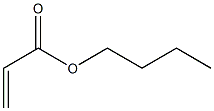9003-49-0

Product Name:
Butyl acrylate resin
Formula:
C7H12O2
Synonyms:
Acrylic acid butyl ester polymer;Butyl acrylate homopolymer;Butyl acrylate polymer;Poly(n -butyl acrylate)
Inquiry
CHEMICAL AND PHYSICAL PROPERTIES
| Physical Description | Butyl acrylate appears as a clear colorless liquid with a sharp characteristic odor. Very slightly soluble in water and somewhat less dense than water. Hence forms surface slick on water. Flash point 105 °F. Density 7.5 lb / gal. Used for making paints, coatings, caulks, sealants, adhesives. |
|---|---|
| Color/Form | Colorless liquid |
| Odor | Sharp, fragrant |
| Boiling Point | 295 to 298 °F at 760 mmHg (NTP, 1992) |
| Melting Point | -84.3 °F (NTP, 1992) |
| Flash Point | 120 °F (NTP, 1992) |
| Solubility | less than 1 mg/mL at 68 °F (NTP, 1992) |
| Density | 0.899 at 68 °F (USCG, 1999) - Less dense than water; will float |
| Vapor Density | 4.42 (NTP, 1992) - Heavier than air; will sink (Relative to Air) |
| Vapor Pressure | 10 mmHg at 95.9 °F ; 4 mmHg at 68 °F (NTP, 1992) |
| LogP | log Kow = 2.36 |
| Autoignition Temperature | 534 °F (USCG, 1999) |
| Decomposition | When heated to decomposition it emits acrid and irritating fumes. |
| Heat of Combustion | 974.46 kcal/mol |
| Heat of Vaporization | 8.11 kcal/mol |
| Polymerization | Hazardous polymerization may occur. Polymerization may be caused by elevated temperature, oxidizers, peroxides, or sunlight. ... Uninhibited monomer vapor may form polymer in vents and other confined spaces. |
| Odor Threshold | Odor Threshold Low: 0.00096 [mmHg] Odor Threshold High: 0.1 [mmHg] Odor threshold from AIHA |
| Refractive Index | Index of refraction: 1.4185 at 20 °C/D |
| Kovats Retention Index | 883 875 876 878 873 878 878 878 878 892 886 |
| Other Experimental Properties | Specific heat: 0.467 cal/g/deg C at -60 °C |
| Chemical Classes | Plastics & Rubber -> (Meth)acrylates |
SAFETY INFORMATION
| Signal word | Danger |
|---|---|
| Pictogram(s) |
 Flame Flammables GHS02  Exclamation Mark Irritant GHS07  Health Hazard GHS08 |
| GHS Hazard Statements |
H225:Flammable liquids H304:Aspiration hazard H315:Skin corrosion/irritation H336:Specific target organ toxicity,single exposure; Narcotic effects H373:Specific target organ toxicity, repeated exposure H412:Hazardous to the aquatic environment, long-term hazard |
| Precautionary Statement Codes |
P201:Obtain special instructions before use. P210:Keep away from heat/sparks/open flames/hot surfaces. — No smoking. P273:Avoid release to the environment. P302+P352:IF ON SKIN: wash with plenty of soap and water. P308+P313:IF exposed or concerned: Get medical advice/attention. |
COMPUTED DESCRIPTORS
| Molecular Weight | 128.17 g/mol |
|---|---|
| XLogP3 | 2.4 |
| Hydrogen Bond Donor Count | 0 |
| Hydrogen Bond Acceptor Count | 2 |
| Rotatable Bond Count | 5 |
| Exact Mass | 128.083729621 g/mol |
| Monoisotopic Mass | 128.083729621 g/mol |
| Topological Polar Surface Area | 26.3 Ų |
| Heavy Atom Count | 9 |
| Formal Charge | 0 |
| Complexity | 97.1 |
| Isotope Atom Count | 0 |
| Defined Atom Stereocenter Count | 0 |
| Undefined Atom Stereocenter Count | 0 |
| Defined Bond Stereocenter Count | 0 |
| Undefined Bond Stereocenter Count | 0 |
| Covalently-Bonded Unit Count | 1 |
| Compound Is Canonicalized | Yes |
PRODUCT INTRODUCTION
description
Butyl acrylate appears as a clear colorless liquid with a sharp characteristic odor. Very slightly soluble in water and somewhat less dense than water. Hence forms surface slick on water. Flash point 105 °F. Density 7.5 lb / gal. Used for making paints, coatings, caulks, sealants, adhesives.
